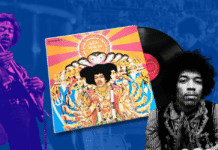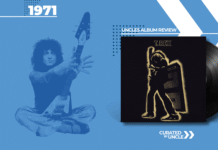“You Can Hear It in the Scars” – Why The Velvet Underground & Nico Still Sounds Like the Apocalypse in Mono
There are albums that gently nudge the boundaries of music. Then there’s The Velvet Underground & Nico, which took those boundaries, fed them heroin, locked them in a grubby New York loft and filmed the whole thing in black and white. Released in 1967 to the sound of almost no one giving a toss, this debut collaboration between The Velvet Underground and Nico was ignored harder than a Jehovah’s Witness at a swingers’ party. And yet, somehow, it became one of the most influential records ever made.
It’s the musical equivalent of a lit cigarette being stubbed out in your ear – jarring, raw, deeply unpleasant in parts – but you can’t stop listening because it’s just that important. If the Beatles were your mum’s idea of rebellion, The Velvets were what happened after the acid wore off and reality came back wearing fishnets and a switchblade.
Let’s peel this banana.
Table of Contents

The Banana: A Warhol-Approved Trojan Horse
Before we even touch the music, let’s address the giant, fruit-shaped elephant in the room: the album cover. Designed by Andy Warhol, the man who turned soup into art and art into capitalism, the original LP featured a banana you could peel off to reveal a fleshy pink… well, something underneath. It was clever, provocative and absolutely pointless – much like Warhol himself.
But it gave the album a sense of mystique, like it might contain dangerous knowledge or at least some form of communicable disease. Warhol was listed as the producer, which in real terms meant he occasionally stood in the studio muttering things like “groovy” and “I think Lou should wear more silver”. Still, his name bought them just enough cultural cachet to get this thing made. Thanks, Andy. Now go back to screen-printing Marilyn Monroe’s corpse.
1. “Sunday Morning”
The album opens with “Sunday Morning”, which is as misleading as putting a croissant on the cover of Cannibal Holocaust. It’s dreamy, almost ethereal, with celesta and whispered vocals. Nico doesn’t sing on it – probably for the best – and Lou Reed croons like someone who’s just woken up and remembered he owes the mob money.
It’s almost annoyingly pretty, which makes what comes next feel like being hugged by a ghost and then immediately mugged by reality.
2. “I’m Waiting for the Man”
Boom. Here comes the freight train. “I’m Waiting for the Man” is a raw, pounding account of waiting for a drug dealer on the corner of Lexington and 125th. It’s not poetic. It’s not metaphorical. It’s just Lou Reed mumbling about scoring heroin like he’s reading a shopping list. Which he basically is.
The repetition is hypnotic, the piano is banging like it’s played by someone with unresolved trauma and the whole thing reeks of sweaty desperation. In a good way. Sort of.
3. “Femme Fatale”
Ah, Nico. The German chanteuse with the emotional range of a malfunctioning ATM. Warhol insisted she join the band, probably because she looked like a fascist fashion model and sounded like a haunted fax machine.
“Femme Fatale” is meant to be about Edie Sedgwick, another of Warhol’s tragic muses. Nico delivers the vocals with all the warmth of a tax audit, which somehow works. It’s detached, cruel and pretty – like being dumped via telegram.
4. “Venus in Furs”
This is where things go full BDSM. Inspired by the 19th-century novel of the same name, “Venus in Furs” is a leather-clad fever dream. John Cale’s electric viola screeches like the cries of a tormented badger and Reed’s lyrics are drenched in sadomasochism.
“Shed your skin / I’ll wait for you” he murmurs, like someone who keeps a chloroform rag in their pocket “just in case.” It’s dark, weirdly sexy and more influential than any of the band’s members could have predicted. Every goth in the 80s owes this song a leather rose.
5. “Run Run Run”
“Run Run Run” is chaotic, messy and sounds like it was recorded during a fire drill. Reed’s guitar solo is basically a war crime. But again, that’s the point. The characters in the lyrics – Teenage Mary, Margarita Passion – are addicts stumbling through life, crashing into death like it’s on special offer.
There’s a jagged brilliance to the disarray, a kind of tuneful nihilism that became punk’s wet dream.
6. “All Tomorrow’s Parties”
This track is Nico’s moment. Her Teutonic warble perfectly suits the dirge-like piano and funeral pace. “What costume shall the poor girl wear…” she intones, as if describing a dead debutante. It’s haunting, tragic and bleakly beautiful.
If someone turned depression into a catwalk show, this would be the soundtrack.
7. “Heroin”
This isn’t a song. It’s a psychotic episode set to music. “Heroin” is seven minutes of Lou Reed basically telling you why he loves stabbing himself with needles. The tempo shifts like a junkie’s heartbeat – calm one second, then racing into chaos.
It’s deeply uncomfortable, brutally honest and still kind of romantic, if you’re the kind of person who sends Valentine’s cards to ghosts. If the goal of music is to make you feel, “Heroin” succeeds by making you want to both lie down and take a shower.
8. “There She Goes Again”
This is probably the most radio-friendly track here, which is like saying a corpse is the most photogenic at a morgue. “There She Goes Again” borrows from soul music, adds a dash of misogyny (just to spice things up), and turns it into jangly indie-pop.
It’s catchy, cynical and sounds like The Rolling Stones if they’d been locked in a cupboard for a week.
9. “I’ll Be Your Mirror”
Here’s Nico again, but this time with something approaching sincerity. “I’ll Be Your Mirror” is a sweet, fragile track – probably the only moment of genuine emotional intimacy on the entire album.
Lou Reed wrote it for her, which is either romantic or masochistic, depending on how you feel about being sung to by a robot programmed to express vague melancholy.
10. “The Black Angel’s Death Song”
John Cale’s viola returns, this time accompanied by Lou Reed reading what sounds like poetry from a Soviet prison cell. “The Black Angel’s Death Song” is impenetrable, abrasive and designed to cause migraines in music executives.
It’s the kind of track that makes your pets leave the room. And again – that’s the point.
11. “European Son”
The album ends with a nuclear explosion disguised as a jam session. “European Son” is over seven minutes of noise, crashes, feedback and Reed whispering something about giving someone the slip. It’s dedicated to Delmore Schwartz, Reed’s old professor, who probably died a little more when he heard it.
This isn’t a song. It’s a middle finger in audio form. And yet it’s glorious.
Cultural Impact: From Flop to Blueprint
When The Velvet Underground & Nico dropped in 1967, it tanked harder than a politician caught hugging Rupert Murdoch. Radio stations didn’t play it. Stores refused to stock it. Critics didn’t know whether to review it or just report it to the police.
But over the next two decades, it seeped into the bloodstream of music like a slow-acting poison. Punk bands worshipped it. Art rock bands copied it. Shoegaze, indie, glam, goth, noise rock and experimental everything – all of it echoes with the album’s DNA.
David Bowie was obsessed with Lou Reed and covered “White Light/White Heat.” U2 thanked the band in their Hall of Fame speech. Kurt Cobain had the record in his collection like a grim rite of passage. And that Warhol-designed banana became the ironic T-shirt for people who want to look edgy without ever hearing “European Son.”
It didn’t just predict the future of music – it invented it while wearing sunglasses indoors.
Legacy: The Sound of the Future
So how did an album that barely sold 30,000 copies on release become one of the most cited influences in music history?
Well, because it was honest. Brutally, beautifully, disturbingly honest. No one else in 1967 was talking about heroin addiction, S&M, gender identity and existential despair over the sound of an electric viola being throttled. The Beatles were off with Mr. Kite and Lucy in the sky. The Velvets were in the gutter, looking up at the blood-stained stars.
Brian Eno famously said that while almost no one bought the album, everyone who did started a band. And those bands – Bowie, Joy Division, Sonic Youth, REM, Nirvana – reshaped music in The Velvet Underground’s jagged image.
Trivia: Things You Didn’t Know But Now Can’t Unknow
- The banana cover was peelable. The original vinyl had a sticker you could peel off to reveal a pink fruit underneath, like erotic fruit-based performance art.
- Lou Reed and John Cale hated each other by the end. The band imploded not long after, proving that genius is allergic to harmony – both musical and personal.
- It was recorded in just four days. Which might explain why some of it sounds like it was captured during a hostage situation.
- “European Son” was a diss track. It was dedicated to Reed’s mentor, Delmore Schwartz, who reportedly hated rock music. This was Lou’s way of saying “thanks” – with seven minutes of sonic violence.
- The album was delayed due to legal issues. There were lawsuits about Nico’s image rights and the music itself. Even the album’s release was a mess – how very Velvets.
- Brian Eno’s famous quote: “The first Velvet Underground album only sold 10,000 copies, but everyone who bought it formed a band.” That might not be mathematically sound, but it’s spiritually accurate.
My Final Thoughts: A Banana That Keeps Ripening
The Velvet Underground & Nico is not for the faint-hearted, the easily bored, or anyone who enjoys traditional concepts like melody or hope. But it’s important, like discovering your house is haunted – unsettling, sure, but it gives you stories to tell.
It’s a landmark in musical expression, a trailblazing, grimy, damaged masterpiece. And like most great art, it wasn’t recognised until years after it staggered out of a loft and collapsed onto vinyl.
If you haven’t listened to it, do so. But don’t expect comfort. Expect a sonic punch in the face from a band that saw the future and decided it needed more noise, more darkness and definitely more German models singing about sadness.

If You Like The Velvet Underground & Nico, I Recommend These Albums:
“Marquee Moon” – Television (1977) – Think of it as what The Velvet Underground might’ve sounded like if they sobered up, learned to play their instruments and moved to CBGBs. Art-punk guitar wizardry meets existential dread in tight trousers.
“Unknown Pleasures” – Joy Division (1979) – Take the bleak alienation of “Heroin,” add a Mancunian accent, subtract any trace of joy, and you’ve got this post-punk masterpiece. The Velvets were the gateway drug; this is the overdose.
“Psychocandy” – The Jesus and Mary Chain (1985) – Imagine The Velvet Underground passed through a blender with Phil Spector’s ghost and a chainsaw. Fuzz-drenched guitars, sweet melodies and enough feedback to terrify dogs. Beautiful noise, just like Lou would’ve wanted.

The Velvet Underground & Nico 45th Anniversary
| # | Track | Duration |
|---|---|---|
| 1 |
Sunday Morning
The Velvet Underground, Nico
|
02:55 |
| 2 |
I'm Waiting For The Man
The Velvet Underground, Nico
|
04:39 |
| 3 |
Femme Fatale
The Velvet Underground, Nico
|
02:39 |
| 4 |
Venus In Furs
The Velvet Underground, Nico
|
05:12 |
| 5 |
Run Run Run
The Velvet Underground, Nico
|
04:22 |
| 6 |
All Tomorrow's Parties
The Velvet Underground, Nico
|
05:59 |
| 7 |
Heroin
The Velvet Underground, Nico
|
07:13 |
| 8 |
There She Goes Again
The Velvet Underground, Nico
|
02:41 |
| 9 |
I'll Be Your Mirror
The Velvet Underground, Nico
|
02:14 |
| 10 |
The Black Angel's Death Song
The Velvet Underground, Nico
|
03:12 |
| 11 |
European Son
The Velvet Underground, Nico
|
07:47 |















